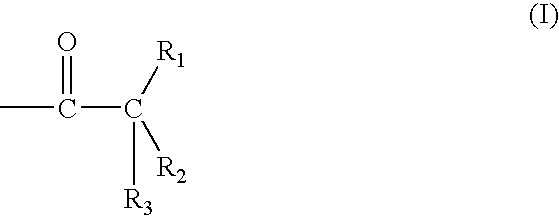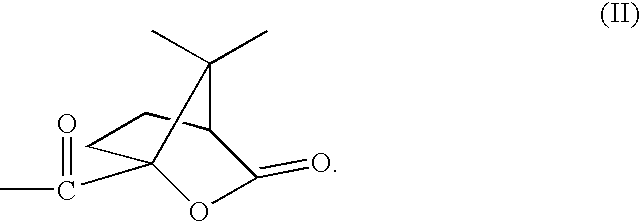High resolution silicon-containing resist
a silicon-containing, high-resolution technology, applied in the field of microelectronics industry, can solve the problems of insufficient resist sensitivity to afford high-throughput manufacturing, reduce the integrity of the pattern, and not extendable to duv and vuv wavelengths, etc., to achieve reasonable sensitivity to imaging radiation, improve resist composition, and reduce the effect of blur
- Summary
- Abstract
- Description
- Claims
- Application Information
AI Technical Summary
Benefits of technology
Problems solved by technology
Method used
Image
Examples
example 1
Synthesis of camphanic group partially protected poly(2-hydroxy-3,3,3-trifluoropropylsilsesquioxane) (FSQ-CAF)
[0053] 7 g of poly(2-hydroxy-3,3,3-trifluoropropylsilsesquioxane) (FSQ) and 4.14 g of camphanic chloride were dissolved in 35 g of GBL and charged into a 100 ml flask. The mixture was stirred under ice bath, while 1.93 g of 4-methylmorpholine was added into the mixture dropwise within 20 minutes. After approximately two hours stirring under the ice bath temperature, the reaction mixture was allowed to warm up slowly to the room temperature and the reaction was continued overnight. The solution was then precipitated in 2000ml DI water. The resulting gel-like polymer was redissolved in acetone and reprecipitated in 2000 ml DI water. The polymer was collected and dried in vacuum oven overnight at 65° C.
example 2
Dissolution Rate and Optical Property Measurements of FSQ-CAF
[0054] 800 mg of FSQ-CAF synthesized in Example 1 above was dissolved in PGMEA to a total weight of 10 g providing the solid content of the polymer in the solution is 8%. This radiation sensitive resist composition was then spin-coated on quartz disk and baked at 110° C. for 60 s. The disk containing resist film was then developed in 0.263N TMAH developer and monitored with Research Quartz Crystal Microbalance (RQCM, RS-232) tool manufactured by Maxtek, Inc. The dissolution rate of FSQ-CAF in comparison to that of FSQ is shown in Table 1 below.
TABLE 1Dissolution rates evaluationPolymerDissolution rateFSQ 11.3 nm / sFSQ-CAF0.134 nm / s
[0055] To measure the optical properties, the resist composition above was spin coated onto silicon wafers, baked on hot plate at 110° C. for 60 s, and then n and k values were measured with VB-250 VASE Ellipsometer manufactured by J.A. Woollam Co. Inc. The optical properties of the resist com...
example 3
E-beam Imaging Evaluation
[0056] Resist formulation with 8% FSQ-CAF in Example 2 was spin coated with 2500 rpm on HMDS primed wafers. The resist was baked on a hot plate at 110° C. for 1 minute to give ˜100 nm thick film. The exposures were performed on a 100 kV Leica exposure system. After exposure, the resist was developed with 0.263N TMAH for 60s. High resolution of 60 nm l / s images was obtained at 420 μC / cm2 with resist lines standing, and 50 nm l / s images were resolved with some lines collapsed. The contrast of the resist is around 3.
PUM
| Property | Measurement | Unit |
|---|---|---|
| wavelengths | aaaaa | aaaaa |
| wavelengths | aaaaa | aaaaa |
| wavelengths | aaaaa | aaaaa |
Abstract
Description
Claims
Application Information
 Login to View More
Login to View More - R&D
- Intellectual Property
- Life Sciences
- Materials
- Tech Scout
- Unparalleled Data Quality
- Higher Quality Content
- 60% Fewer Hallucinations
Browse by: Latest US Patents, China's latest patents, Technical Efficacy Thesaurus, Application Domain, Technology Topic, Popular Technical Reports.
© 2025 PatSnap. All rights reserved.Legal|Privacy policy|Modern Slavery Act Transparency Statement|Sitemap|About US| Contact US: help@patsnap.com



